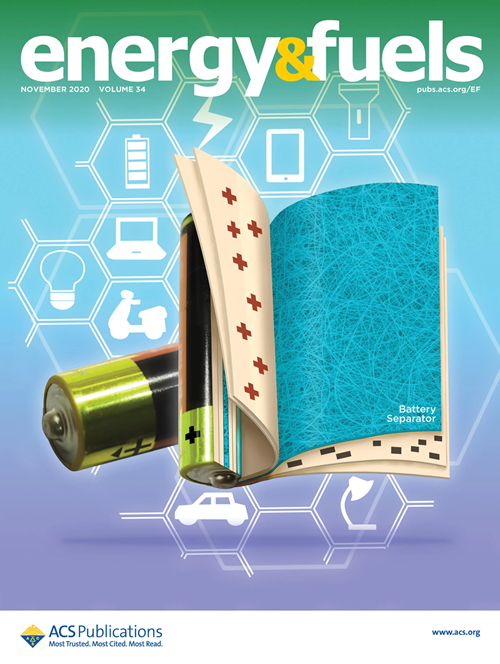脱水使高浓度果糖高效合成 5-乙氧基甲基糠醛和乙酰丙酮作为候选生物燃料
IF 5.3
3区 工程技术
Q2 ENERGY & FUELS
引用次数: 0
摘要
将果糖一次性转化为 5-乙氧基甲基糠醛(EMF)和乙酰丙酸乙酯(EL)等生物燃料候选物质,避免了不稳定的中间产物 5-羟甲基糠醛(HMF)的耗能分离过程,从而为未来的生物炼油厂提供了一条前景广阔的途径。然而,这种串联反应本身的工艺效率较低,原因是反应动力学缓慢,而且脱水步骤中形成的水很容易诱发不需要的腐殖质的形成。在此,我们报告了一种脱水策略,即通过添加硅胶作为脱水试剂和助催化剂,将高浓度果糖(10-30 wt %)高效转化为 EMF 和 EL。在 1.0 克硅胶的作用下,果糖在乙醇中于 140 °C 下反应 30 分钟,最高产物收率为 ∼87.0 mol%,时空收率(STY)为 ∼7.7 × 10-1 mol-L-1-h-1。动力学研究表明,果糖-HMF 脱水、HMF-EMF 醚化和 EMF-EL 醇解都会因脱水而加速,对前两个步骤的促进作用更为显著。与不脱水的工艺相比,以 STY 表示的工艺效率明显提高。这种脱水策略适用于同质和异质催化的果糖-EMF/EL 转化,且底物范围广泛。这为提高未来生物炼制厂的生物燃料生产效率提供了一种实用的策略。本文章由计算机程序翻译,如有差异,请以英文原文为准。

Water Removal Enables High-Efficacy Synthesis of 5-Ethoxymethylfurfural and Ethyl Levulinate as Biofuel Candidates from High-Concentration Fructose
The one-pot conversion of fructose into biofuel candidates such as 5-ethoxymethylfurfural (EMF) and ethyl levulinate (EL) avoids the energy-consuming separation of the unstable intermediate product 5-hydroxymethylfurfural (HMF), thereby representing a promising route for future biorefineries. However, this tandem reaction has an inherently low process efficiency owing to the slow reaction kinetics and facile formation of unwanted humins induced by the presence of water formed in the dehydration step. Herein, we report a water-removal strategy for the high-efficacy conversion of high-concentration fructose (10–30 wt %) to EMF and EL by the addition of silica gel as both a dewatering reagent and cocatalyst. The highest product yield of ∼87.0 mol % with a space-time yield (STY) of ∼7.7 × 10–1 mol·L–1·h–1 is achieved by reacting fructose in ethanol at 140 °C for 30 min under the action of 1.0 g of silica gel. A kinetic study reveals that fructose-to-HMF dehydration, HMF-to-EMF etherification, and EMF-to-EL alcoholysis are accelerated by water removal, and the promotional effect on the former two steps is more remarkable. The process efficiency, expressed as STY, improved remarkably compared to those without water removal. Such a water-removal strategy is applicable to both homo- and heterogeneously catalyzed fructose-to-EMF/EL conversions with a wide substrate scope. This provides a practical strategy for enhancing the efficiency of biofuel production in future biorefineries.
求助全文
通过发布文献求助,成功后即可免费获取论文全文。
去求助
来源期刊

Energy & Fuels
工程技术-工程:化工
CiteScore
9.20
自引率
13.20%
发文量
1101
审稿时长
2.1 months
期刊介绍:
Energy & Fuels publishes reports of research in the technical area defined by the intersection of the disciplines of chemistry and chemical engineering and the application domain of non-nuclear energy and fuels. This includes research directed at the formation of, exploration for, and production of fossil fuels and biomass; the properties and structure or molecular composition of both raw fuels and refined products; the chemistry involved in the processing and utilization of fuels; fuel cells and their applications; and the analytical and instrumental techniques used in investigations of the foregoing areas.
 求助内容:
求助内容: 应助结果提醒方式:
应助结果提醒方式:


